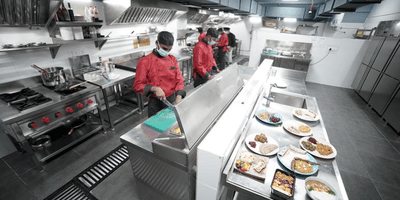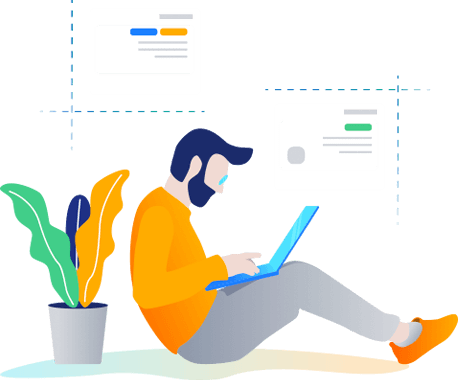Cloud kitchen, the latest disruption in F&B sector has silently sneaked in from the back door. The way investor community is supporting cloud kitchen start-ups, is something to take note of. Reports suggest that the Cloud kitchen concept is marching ahead at the highest CAGR than the other segments in the restaurant industry.
So, What is a Cloud kitchen or Dark kitchen? What makes these kitchens a hot trend among the start-ups? Is there any risk for restaurant owners in the future with the rise of this concept? These are some very obvious questions that pester you mind.
We will shed some light on this hot topic and dig deeper through whys and hows of it to get a clearer picture.
What is the Cloud kitchen?
Cloud kitchen is a phenomenon in which a small food outlet or group of food brands share kitchen space under one roof. But there are no options for dine-in. You just can take away your food order or you get it delivered by ordering through apps like UberEats or the kitchen’s app. So in a broader sense, it is a delivery-only restaurant.
Ghost Kitchen, Dark Kitchen, and Virtual Kitchen are some other names for a Cloud Kitchen.

What Makes Cloud Kitchen Popular Food Startup idea?
As stated earlier, these kitchens are of a delivery-only format, hence you don’t need to spend big on infrastructure cost. Instead, you can focus on your food quality, quicker turn around and providing faster delivery to your customers.
Let’s figure out how exactly it works?
Step 1: Customer places the order.
Step 2: Kitchen receives the order details.
Step 3: The meal is prepared.
Step 4: Prepared food is packed.
Step 5: Delivery guy picks up and delivers it to the customer.
You see, there is no involvement of any waiter or the need of any sitting arrangement. Only chefs working on different offered cuisines and a person for packing the food and handing it over to the designated delivery guy are involved.
You may wonder what makes the cloud kitchen a lucrative concept for the business?
1) Lower Infrastructure Cost
Since you are having only a small space for cooking the meal without the need for tables and other facilities, you save on the overhead expenses, considerably. It only needs a one-time investment on the utensils and other kitchen-related items.
2) Scalable in Future
One of the positive aspects of having your own cloud kitchen business is, that you can expand your kitchen outlets in different areas of your city. One kitchen can deliver to about a 2- 3 miles radius area. In the future, you could open a new outlet at a different location where you think you will get good traction.
3) Low Overhead Cost
Your profit margin is the main purpose of opening a cloud kitchen. You DON’T need to pay for fancy doors & décor or have a main road entrance & costly client facing staff or reserved parking area.
Cloud kitchens have their share of disadvantages as well. However, compared to its advantages, the negative aspects can be overcome if planned well. Some of the cons of cloud kitchen are;
- 1) High Competition (because of no-entry barriers)
- 2) Heavy Dependence on Food Aggregators (unless you have your own fleet & app)
- 3) Masked Customer Information (you wouldn’t know your customers)
- 4) Direct competition with Food Aggregators (UberEats, Zomato, Swiggy)
Case Study: Faasos
Working in: 15 cities & 200+ Locations
Customers: 40 lakhs
Multiple successful cloud kitchens are operating throughout the world. And the concept is getting popularity like never before.
Faasos( Also known as Rebel Foods) was started in 2011 by two young entrepreneurs of India and they have established Faasos in one of the top cloud kitchen companies in the world. Faasos till now has garnered a total amount of $276.1 m in investment and expanding its empire globally.
Faasos Business Model
Faasos has adopted a cloud kitchen model that houses a few recognized brands namely, Faasos, Oven Story, Firangi Bake, Mandarin Oak, Kettle & Kegs and Behrouz. The company was initially running as a Quick Service Restaurant, but then it added these popular brands.
Faasos has its mobile application and delivery personnel. Additionally, it has also registered its business on local aggregator food delivery apps like UberEats, Zomato & Swiggy. So the user has multiple options to order from Faasos.
Customers can order food like Indian meal boxes, Chinese, South Indian, Rice & Biryani combos, variety of wraps, and desserts from mobile app or website.
How can you start a Cloud kitchen?
Do you have your restaurant? If yes, then investing in a virtual kitchen will enhance your overall exposure and add more profit with less investment.
Cloud kitchen will always require less investment compared to any dine-in restaurant. Here’s what you need to get started.
Kitchen Space
It depends on how many cuisines you are going to serve. If you are thinking of something big and have chefs that are experienced in multiple cuisines, you should look at a kitchen space between 800 to 1200 square feet.
Now if you want to open your kitchen space in a prime spot, then you will have to be ready for more investment than in non-prime spots. You know your city better. So, do a survey before deciding the location.
Kitchen equipment
Now, your major chunk of investment is going to go into kitchen equipment. Depending on the cuisines you are providing, you have to have the required kitchen equipment. Refrigerator, Oven, Chimney, and Utensils are some of the common things you need.
Kitchen staff
Since your kitchen will be recognized with your unique food, you should not compromise on the person behind making that food. You should hire a proficient chef for your kitchen. You can extend the chef staff as you increase your offerings. (Do your mom cook the best food? Why not make her the Cook? That way you will have your USP & also save some cost.)
You will need one person for packing the food and one person for handling the billing of the food order.
Licensing & POS
You will need the local food & beverage industry compliance before hopping onto the business. Moreover, You will need PoS software for billing and inventory. That way you can manage your order and staff better. Cloud-based PoS systems are a trend nowadays.
Kitchen Space
I know your first question would be [ Let's Contact ] How much does it cost to make an app? But the cost of app development depends on multiple factors.
For now, just remember it can cost to between $2k to $40k. if you don’t want to build your app then you can register your kitchen’s name in the local food delivery apps. They will charge you a pre-decided commission on a particular order.
If you do have your own app and delivery boys, all the benefits go to your account. You will have more control over your food related operations.
Business models for cloud kitchen
There is not one business model in the cloud kitchen and every model has different revenue generation methods.

Conclusion
Undoubtedly, the future of the F&B industry is in Cloud kitchen. Of course, restaurants will have their share of dining experience but virtual kitchens will be the first preference where convenience and mobility are critical.
What are your thoughts on this concept? Would you like to invest in such an idea?
